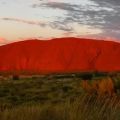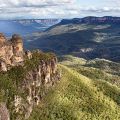A Spiritual Experience At Uluru!

Up for a vacation? Decided on your destination? For a change, try a spiritual holiday at Australia’s Red Centre, better known as Ayers rock a.k.a the sacred ‘Uluru’, to experience a heavenly feel. There are many interesting things to do in Uluru as well as activities that centre around the ancient aboriginal culture associated with the region. Going on an Uluru sightseeing tour is hence a bucket-list favourite and comes highly recommended by travel-bugs world over!
To begin with, Uluru is considered a ‘holy land’ because it is so much more than a rock in the middle of nowhere! It’s the living cultural landscape of the local tribe, who worship the rock as their entity.
The indigenous people called the Anangu have been around for over 60,000 years, and is one of the oldest cultures known to the world. The Anangu still strictly follow the ancient laws and traditions laid down by their elders and hold Uluru in high regard, as they believe the spirits of their ancestors reside in these rocks. So they dissuade visitors from climbing Uluru and request you to respect their spiritual beliefs.
Some of the sites are off-access to the public, and only Anangu who have been initiated into the tribe can visit these sacred areas. Initiation is no easy feat to accomplish, as the elder men in this patriarchal society pour blood from self-inflicted arm and chest wounds, for the continuance of their tribe on Earth.
Despite being exposed to 21st century modernities, Anangu still maintain their language and culture to the strictest level. They have given up their nomadic hunting and gathering lifestyle, but still live in scattered small communities and outstations across their traditional lands.
Here are some ice-breaker phrases to keep in mind when you visit Uluru. In their language, Anangu loosely translates to ‘human being’. It’s always nice to start with a hello and they use the word 'palya' for the same. In English, it is pronounced similar to pull (like pull-ya). Another word to keep in mind is ‘uwa’ which translates to ‘yes’.
‘Tjukurpa’ (pronounced 'chook-orr-pa' in English) is the cornerstone of Anangu culture, and the foundation of the Anangu way of life. A foundation that is rock-solid for over 60,000 years, Tjukurpa tells of the relationships between people, plants, animals and the physical features of the land. It refers to the past, the present and the future at the same time. Also known as ‘creation time’, this knowledge never changes, it always stays the same. The Anangu culture has a historical significance dating back hundreds of centuries, and experiencing this is a refreshing, probably even life-changing experience, for many!
Apart from the rich culture, the ‘Anangu’ people are good with colours. Their paintings are full of symbols that depict their living culture. The fiery red centre is also geologically beautiful with many lush green pockets that are home to some unique flora and fauna.
You are not just going down to a bed of rocks, but to an entire ecosystem that is entwined in the ancient indigenous culture of the ‘Anangu’. So if you’re someone who enjoys the mysteries of a fable but are still rooted to society, you are sure to fall in love with Uluru!
One question still remains though, would you or would you not climb Uluru?
Other articles and publications:
- +1 (612) 829-6736
- 32 The Promenade, King Street Wharf, https://www. tourchief. com/







